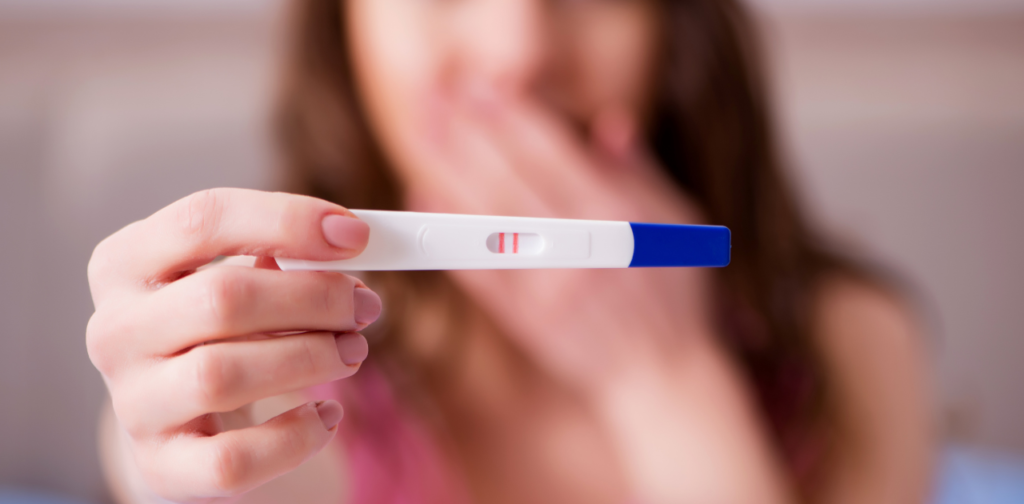Understanding how to decipher Clear Blue pregnancy test results is critical to obtaining accurate information. Begin by carefully following the instructions, ensuring you collect a urine sample correctly and perform the test as directed. Once completed, observe the test during the specified waiting period, noting any lines or digital displays that appear. Remember, a positive result typically indicates pregnancy, while a negative result suggests otherwise.
It’s crucial to avoid misinterpretation by familiarizing yourself with the different Clear Blue tests available and their respective result indicators. By mastering the process of reading Clear Blue pregnancy tests, you can confidently navigate this critical step in family planning.
What is a pregnancy test?
A pregnancy test is a diagnostic tool to determine whether a woman is pregnant. It detects the presence of human chorionic gonadotropin (hCG), a hormone produced by the placenta shortly after implantation. Pregnancy tests are typically available over the counter at pharmacies and can be performed by healthcare professionals in clinical settings.
How Do Pregnancy Tests Work?

Detection of hCG: Pregnancy tests work by detecting the presence of hCG in urine or blood samples. hCG is only produced by the body during pregnancy, making it a reliable indicator of pregnancy.
Immunoassay Method: Most pregnancy tests utilize an immunoassay method, where antibodies specific to hCG detect the hormone in the sample. When hCG is present, it binds to these antibodies, triggering a visible reaction that indicates a positive result.
Threshold Sensitivity: Pregnancy tests have a threshold sensitivity level, meaning they can detect hCG at specific concentrations in the sample. Tests with higher sensitivity levels can detect pregnancy earlier than those with lower sensitivity levels.
Visual Indicators: Depending on the type of test, results may be displayed as lines on a test strip, a change in colour, or a digital display indicating “pregnant” or “not pregnant.”
Accuracy: When used correctly and at the appropriate time, pregnancy tests are highly accurate, with most modern tests boasting accuracy rates of over 99%.
Confirmation: While a positive result on a pregnancy test is a strong indication of pregnancy, confirmation by a healthcare professional through blood tests or ultrasound is typically recommended for certainty.
Types of Clear Blue Pregnancy Tests

Clear Blue offers a variety of pregnancy tests to suit different preferences and needs. The most common types are digital tests, line tests, and early detection tests.
Digital vs. Line Tests
- Digital Tests: Clear Blue digital tests provide results in a clear digital format, typically displaying “pregnant” or “not pregnant” on a digital screen. These tests eliminate the need for interpretation, making them user-friendly and straightforward.
- Line Tests: Clear Blue line tests, on the other hand, use traditional line indicators to display results. Users must interpret the appearance of lines on the test strip, with specific configurations indicating a positive or negative outcome. While these tests may require more interpretation, they are still reliable and widely used.
Early Detection Tests
Clear Blue offers early detection tests to detect pregnancy before a missed period. These tests are susceptible to low levels of hCG and can provide accurate results several days before the expected period. Early detection tests offer peace of mind and allow women to confirm pregnancy at the earliest possible stage.
How to Read the Instructions
Reading the instructions provided with a pregnancy test is crucial for obtaining accurate results. Here’s a step-by-step guide on how to interpret and follow these instructions effectively:
- Carefully Review the Package Insert: Start by thoroughly reading the pregnancy test’s package insert or leaflet. This document contains important information about using the test correctly and what to expect from the results.
- Pay Attention to Timing: Note any specific timing instructions in the package insert. Some tests require waiting a certain amount of time before reading the results, while others may have different time frames for collecting urine samples.
- Understand Result Indicators: Familiarize yourself with the symbols or indicators used to display test results. Understanding what each result means is essential for accurate interpretation, whether it’s lines on a test strip or digital displays.
- Follow the Step-by-Step Instructions: Carefully follow the instructions in the package insert. This includes collecting a urine sample, performing the test according to the specified method, and interpreting the results correctly.
- Avoid Common Mistakes: Be mindful of common mistakes that can affect the accuracy of the test, such as using an expired test kit, misreading the results, or not following the instructions precisely.
- Seek Clarification if Needed: If you’re unsure about any aspect of the instructions or the test procedure, don’t hesitate to seek clarification from the manufacturer’s customer service or a healthcare professional.
Read to know more: Navigating the Frustration of an ‘Invalid’ Pregnancy Test
When to Take the Test
Determining the optimal time to take a pregnancy test is crucial for obtaining accurate results. Here are some timing considerations to keep in mind:
Timing Considerations
- Menstrual Cycle Tracking: Understanding your menstrual cycle can help you pinpoint the best time to take a pregnancy test. Typically, waiting until after your missed period is recommended to achieve the most reliable results.
- Early Detection Tests: Some pregnancy tests are designed for early detection, allowing you to test several days before your expected period. These tests are susceptible to low levels of the pregnancy hormone hCG, but remember that the accuracy may vary depending on how early you test.
How Soon Can You Take the Test?

The timing of when you can take a pregnancy test largely depends on the sensitivity of the test and your menstrual cycle. While some tests claim to detect pregnancy as early as six days before your missed period, it’s essential to remember that testing too early may result in a false negative.
For the most accurate results, it’s generally recommended to wait until after your missed period to take a pregnancy test. This allows hCG levels to rise sufficiently for detection, increasing the likelihood of an accurate result. Consulting with a healthcare professional can provide personalized guidance if you need help with when to test or have irregular cycles.
Steps to Read a Clear Blue Pregnancy Test
Reading a Clear Blue pregnancy test involves several essential steps to ensure accurate results. Here’s a breakdown of the process:
Collecting Urine Sample
- Gather Supplies: First, ensure you have all the necessary supplies, including the Clear Blue pregnancy test kit and a clean, dry container for collecting urine.
- Choose the Collection Method: Decide whether you’ll collect urine directly onto the test stick or in a separate container. Follow the instructions provided with the test kit for the recommended method.
- Collect Urine Sample: Collect a urine sample in the container or directly onto the test stick according to the instructions. Be sure to use the first urine of the day for optimal test accuracy.
Performing the Test
- Prepare the Test: Remove the test stick from its packaging and remove the cap to expose the absorbent tip.
- Perform the Test: Place the absorbent tip of the test stick in the collected urine sample for the specified amount of time, as indicated in the instructions. Ensure that the absorbent tip is fully immersed in the urine.
- Wait for Results: After completing the test, lay the test stick flat on a clean, dry surface and wait for the specified period before interpreting the results. Avoid moving or disturbing the test during this time.
Interpreting Test Results
Interpreting the results of a Clear Blue pregnancy test accurately is essential for understanding the outcome. Here’s how to interpret different results:
Positive Result
- Definition: A positive result indicates the presence of the pregnancy hormone human chorionic gonadotropin (hCG) in the urine sample, which typically means pregnancy.
- Digital Test: A digital Clear Blue test usually displays a positive result as “pregnant” on the digital screen.
- Line Test: A-line test indicates a positive result by appearing distinct lines in the result window. Even a faint line can indicate a positive outcome.
- Next Steps: If you receive a positive result, it’s advisable to follow up with a healthcare professional for confirmation and to discuss the next steps regarding prenatal care.
Negative Result
- Definition: A negative result suggests that hCG levels were not detected in the urine sample, indicating that pregnancy has not occurred at the time of testing.
- Digital Test: On a digital Clear Blue test, a negative result is usually displayed as “not pregnant” on the digital screen.
- Line Test: A-line test indicates a negative result by the absence of any visible lines in the result window.
- Next Steps: If you receive a negative result but still suspect you may be pregnant, consider retesting after a few days or consulting with a healthcare professional for further evaluation.
Invalid Result
- Definition: An invalid result occurs when the test cannot clearly indicate an outcome due to issues such as insufficient samples or testing errors.
- Causes: An invalid result may occur if the test was not performed correctly, the urine sample was too diluted, or the test kit malfunctioned.
- Next Steps: If you receive an invalid result, it’s recommended that you repeat the test with a new kit, following the instructions carefully. If the problem persists, contact the manufacturer’s customer service for assistance or consult with a healthcare professional for further guidance.
Tips for Accurate Results
To ensure accurate results when using Clear Blue pregnancy tests, consider the following tips:
- Test in the Morning: The first urine of the day is more concentrated and contains higher levels of hCG, which can increase the test’s sensitivity and accuracy.
- Avoid Excessive Fluid Intake: Drinking too much fluid before testing can dilute the urine, potentially affecting the accuracy of the results. Limit intake to prevent this.
- Check Expiration Date: Always check the expiration date of the test kit before using it. Using an expired test can lead to inaccurate results, so ensure the kit is within its validity period.
- Follow Instructions Carefully: Read and follow the instructions provided with the test kit meticulously. Skipping steps or not adhering to timing guidelines can impact the reliability of the results.
- Use a Clean Container: If urine is collected separately, use a clean, dry container to avoid contamination. Any impurities in the sample can affect the test outcome.
- Wait for the Specified Time: After performing the test, wait for the specified time mentioned in the instructions before reading the results. Premature interpretation may lead to inaccuracies.
- Store Test Properly: Store the test kit in a cool, dry place, away from direct sunlight and moisture, as exposure to unfavourable conditions can degrade its performance.
FAQs:
How accurate are Clear Blue pregnancy tests?
Clear Blue pregnancy tests boast high accuracy rates, with digital tests being over 99% accurate when used from the day of your expected period.
Can medications affect the results?
Some medications, particularly those containing hCG, may affect the test results. It’s essential to consult a healthcare professional to clarify how your medications might impact the test.
What does it mean if the test shows a faint line?
A faint line usually indicates a positive result, albeit with lower hCG levels. It’s still considered a positive result, but retesting after a few days to confirm is advisable.
Is it possible to get a false positive result?
While rare, false positive results can occur due to certain medical conditions or medications. However, Clear Blue tests are highly accurate when used correctly.
Can using expired tests affect accuracy?
Yes, using an expired test can lead to inaccurate results. Always check the expiration date before using a pregnancy test.
Conclusion:
In conclusion, mastering the art of reading Clear Blue pregnancy tests is crucial for obtaining accurate results and peace of mind. By following the instructions carefully, understanding the different types of tests available, and considering timing considerations, individuals can confidently navigate this critical step in family planning.















